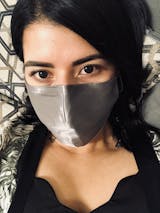Do you ever wonder if the sustainable beauty brand revolution actually makes a difference? Or is it all just hype? What are the benefits of making conscious consumer choices when it comes to eco-friendly skincare?
In this article, we take you through the tangible benefits of using sustainable beauty brand products and supporting clean beauty. You’ll learn how eco-friendly skincare innovation and green beauty are paving the way for a new world, or simply a world.
What Are The Benefits Of Using Eco-Friendly Products?
An eco-friendly beauty product is made with holistic health in mind. Sustainable green beauty brands do the work to ensure that each product is healthy for the planet, and for you. By supporting eco-friendly beauty brands and sustainable skincare brands you can ensure that you help to defund companies that operate unethically.
Companies that knowingly contaminate waterways, the environment, and your body can only do so if you keep buying their products. Choosing to spend your hard-earned cash in the right place is a small contribution of sacred activism that ensures you stand for what you believe in.
Sustainable Skincare Brands:
- Consider every aspect such as sustainably sourced raw materials, product manufacture, distribution, sales, consumer use, and post-consumer use to ensure that their skincare products cost as little as possible in terms of personal health and environmental health, so that you don’t have to.
- Help to protect the ocean from plastic and toxic packaging that doesn’t biodegrade.
- Reduce passive animal cruelty through polluted environments that are inhabited by wild animals and wildlife.
- Help to improve public health through omitting well-known contaminants, toxic chemicals, and persistent organic pollutants (POPs) from their beauty products.
- Ease the financial strain on the healthcare system by removing clinically proven contaminants, toxic chemicals, and persistent organic pollutants (POPs) that are linked to a wide array of health issues from their beauty products.
- Enhance the quality of the food chain by improving the environmental effects of beauty and skincare products.
- Can be trusted to ensure that consumer needs are a priority, as opposed to ignoring well-known medical and academic research for financial gain.
Why Is It Important To Use Sustainable Beauty Products?
Sustainable beauty products are made ethically and take into account your health, and the health of the planet. Sustainable skincare brands prioritize the long-term effects of their products over short-term monetary gain. By choosing green beauty products you can ensure that your lifestyle does not damage the earth that you rely on for survival.
There are endless academic studies that show the mainstream beauty industry is a huge contributor to environmental damage. The American Congress of Obstetrics and Gynecology (ACOG) has even emphasized that toxic environmental disrupters and chemicals are a risk to human health and human reproduction.¹
Our environment and the world rely on a delicately balanced ecosystem that allows us to breathe and survive. What we put into the earth is extremely important as the ecosystem relies on cyclical systems such as the hydrologic cycle (water cycle).
The hydrologic cycle is built on 5 part structure that includes; condensation, precipitation, infiltration, runoff, and evapotranspiration.² In order for the water cycle to function sustainably, the water that is released from the clouds in a process known as precipitation (rain) must also be replenished in the clouds.
After it rains, infiltration allows the water to enter into the ground from the earth’s surface. When rainwater is unable to infiltrate into the ground due to over-saturation or water-resistant materials, this begins the runoff process.
Water runoff flows overland and into bodies of water such as rivers due to the landscape, which then joins into the oceans. Fun fact, 96% of the earth’s water is in the ocean.³ And roughly 90% of the water cycle is supplied by evaporation from the ocean. This means it’s a pretty sure bet that looking after the ocean is extremely important.
This is followed by evapotranspiration which is responsible for putting the water back into the atmosphere. Evapotranspiration allows the rain to nourish the earth again. This is where the cycle of condensation and precipitation starts all over again. Now I know you came here for eco-beauty wisdom, not a geography lecture. But logic and science are inexplicably relevant for conscious consumers, so stay with me.
Why is the water cycle (hydrologic cycle) relevant to your beauty routine?
Well I dunno about you, but I like breathing and nourishing my body with clean water. In fact, neither of us would be here without it. And how do we breathe? Through plants and photosynthesis my friend; plants and photosynthesis.
The environment, trees, and every living plant rely on the water cycle. Plants rely on three different factors to survive; nutritious water, sunlight, and carbon dioxide. They absorb water through their roots, digest carbon dioxide from the atmosphere, and use sunlight as energy to survive in a process called photosynthesis.
Plants are cute, but they aren’t just cute. We would not be alive without them, because during photosynthesis plants create oxygen. Et voila, we literally rely on the water cycle, environment, and plants to survive. This little piece of scientific education is truly enlightening. Because it then becomes baffling that looking after the environment would ever be an after-thought rather than a priority, right?
When we start messing around with the health of our water cycle, there are endless cascading effects on human health and the world.
What Are The Harmful Effects Of Plastic?
Plastic packaging is not only damaging to the environment it has also been proven to be damaging to human health too. In 2019 the National Geographic noted that roughly 8 million tonnes of plastic waste contaminate the ocean annually.¹²
The beauty industry is partly responsible from pretty plastic bottles all the way to exfoliating microplastics. According to Forbes, the beauty industry is reported to be responsible for 120 billion units of packaging per year, and you only have to walk down the cosmetics aisle to figure out what most of these 120 billion units of packaging are mainly made from.¹³
So why is plastic actually such a problem?
Well, other than being non-biodegradable, polluting the food chain, being hazardous to wildlife, the environment, and the delicate ecosystem we rely on to survive, it’s harmful to your health too. Plastic is that joyous gift that never seems to want to stop giving.
A 2018 study by the Indian Journal of Pediatrics noted that plastics are a serious threat to consumer health and the environment in a variety of ways.¹⁴ Researchers are divided on whether plastic additives and preservatives such as phthalates should be considered carcinogens or intoxicants. But they have agreed that they are endocrine disrupters that have a harmful impact on human health.
Three different reports have found that personal care products sold by widely accepted mainstream beauty brands contain chemical additives, preservatives, and ingredients that lack reputable safety data.¹⁵
Phthalates are found in plastics, and within beauty and skincare ingredients such as nail polish, perfumes, lotions, and hairspray - despite them being known to cause a variety of health hazards all the way from reproductive toxicity to skeletal anomalies and asthma.¹⁶
The lack of consensus seems to be down to the classic ‘safety in low-level exposure’ narrative. That completely ignores chronic simultaneous exposure from a variety of different sources.
Even though it may not feel that helpful, there is a gem of wisdom in this academic debacle. The ‘low-level exposure’ safety guideline tells us that it’s worth paying attention to our environment, what we buy, what we consume, and what we put onto our bodies.
Because the truth is, no one can entirely eliminate all of these invisible hazards lurking in the environment, and many of them do seem somewhat out of our control. But you certainly can take back control and empower yourself by making conscious choices to limit your exposure where possible, which limits your overall ‘chronic exposure’. And sustainable beauty is as good a place to start as any.
What Is The Bioaccumulation Of Beauty Products?
Bioaccumulation is the accumulation of contaminants and toxins in living organisms such as fish, which are a major part of the food chain. Bioaccumulation occurs when an organism absorbs the contaminant at a much faster rate than it can get rid of or use it through digestion or elimination.
Clinical research by the Univerity of Sassari highlights the issues of bioaccumulation, environmental pollutants, and many of the common chemicals found in beauty products across the world such as parabens, UV filters, triclosan, and plastic microbeads.⁵ Some of the chemicals that bioaccumulate are known as persistent organic pollutants (POPs) because they do not biodegrade and are resistant to normal environmental degradation.
Substances disappearing down the drain or into the atmosphere from body wash or hair spray appear to be lost. Poof. Gone forever. But it simply isn’t true, science proves that unfortunately many of them don’t disappear without a trace. There is research to prove that the chemicals we are adding into beauty products are bioaccumulating. And some of them are suggested to be pretty toxic to our delicate ecosystem, and our bodies. ‘Pretty toxic’ is an understatement, but let’s avoid a doomsday speech.
The bioaccumulation of pharmaceuticals and personal care product chemicals shows that it’s about time we started being a little more conscious of how we live our lives.
Why is bioaccumulation important?
Living organisms that are victims of bioaccumulation can be part of the human food chain, and it’s a passive form of animal cruelty. The goldfish exposed to the Canadian waste-water outflow in Ontario did not request a prescription of the anti-depressant fluoxetine. Neither did the carp ask for a dose of the sedative diazepam which is used to treat anxiety, seizures, and insomnia.⁶
To be fair, I certainly wouldn’t bat an eyelid or turn them down if they did ask for a prescription. The madness that they have to put up with as a result of human behavior is enough to result in anyone legitimately needing fluoxetine or diazepam.
Biomagnification is another aspect of the process of bioaccumulation. Biomagnification is when the toxin is of a higher concentration than the living organisms' food. This often happens when the primary exposure is in the organism’s food.
We can observe this happening in the food chain whereby toxins settle into the sediment of the ocean, and they are eaten by smaller fish, which are then eaten by bigger fish. Fish which are larger are more likely to have higher levels of toxic chemicals in their bodies due to the contamination of their food source.⁷
Now we must take note here, because if we can see through academic research that personal care product chemicals are bioaccumulating and bio-magnifying in food sources below humans in the food chain... it’s pretty easy to see what that means for us.
The evidence of biomagnification of harmful contaminants within a wide variety of our food sources means that these chemicals could ultimately end up biomagnifying in us too. Clinical research by Environment International in 2016, studied the placentas of new mothers after birth.
They found that a variety of parabens and benzophenone-1 were found in their placenta’s which gives us an interesting insight into the effects of not only what we put on the body, but also what we put into the environment. Benzophenone-1 is a well-known endocrine disrupter that has been linked to stimulating breast cancer.¹¹ This is the literal definition of high-cost beauty.
Research by the International Journal Of Cosmetic Science in 2007, studied the permeability of parabens into the body through the skin. They found that parabens are capable of permeating through the skin and that they could also potentially accumulate in the skin.
The Environment International study is of particular concern because we already have a variety of evidence that points to environmental chemicals and persistent organic pollutants (POPs) being the culprit of a wide variety of health issues. And their study shows that even babies in the womb are exposed to harmful chemicals through the very organ that should be nourishing them. Not cool.
A study by the American Journal of Obstetrics and Gynecology confirms that common beauty products contain a variety of ingredients that are legally sold on the shelves of shops worldwide, and are a danger to optimal health.¹ There is a long list of chemicals that have been linked to health issues such as breast cancer, reproductive system problems due to their endocrine-disrupting nature, and more. ⁹ ¹º
Ethical And Sustainable Beauty And Skincare Brands Making A Difference
Here are some of the brands that we support at Fait avec Coeur that have made a commitment to you, the earth, and the generations to come. They proudly stand by their dedication to ethical consumerism and conscious capitalism, and we really hope you choose to support them too.
They focus on sustainable cosmetics and sustainable products made with natural ingredients that are free from harmful chemicals, fillers, or preservatives.
Dew Mighty
Dew Mighty is zero-waste and plastic-free, and they also use beautiful custom reusable containers for their innovative minimalist serum bars.
UpCircle
UpCircle is palm oil free, uses 100% recyclable packaging, and has a strong brand value of emphasizing the vast possibilities of a circular economy and eco-friendly beauty products. They upcycle coffee from British coffee shops and transform it into powerful natural skincare and sustainable products.
Axiology
Axiology makes vegan, zero-waste, and plastic-free green cosmetics. Their 3-in-1 minimalist beauty lip balm crayons are also wrapped in recycled paper waste. Be sure to check out their amazing sustainable cosmetics.
Earthwise Beauty
All of the Earthwise Beauty products are packaged in glass jars with fully recyclable lids or recyclable paper boxes. Their gift packaging is 100% biodegradable and natural. They use the most delicious raw materials that are sustainably sourced.
Conclusion
The main benefit of sustainable skincare brands and eco-friendly beauty brands is that they do the thinking for you. With all the other challenges and duties of life calling, making the effort to contribute to clean beauty can sometimes just feel like a massive burden.
By choosing to fund brands that are committing to do the research and produce truly ethical products that work, you’ve essentially had half of your contribution to sacred activism done for you. At Fait avec Coeur we proudly challenge the status quo and are happy to support any brand that is willing to take a stand with us.
Carmen Lee is a certified yoga teacher, childbirth doula, and wellness coach. She educates on womb wellness, sacred wisdom, and ancestral-connected living. You’ll find her passionately advocating radical self-care and transformational self-empowerment through sustainable beauty and self-love rituals.
Some of the products promoted in our blog are from our online store. Many others are brands we have researched and found to be great examples of sustainable, ethical, and innovative brands in their field, and we don't make any profit from mentioning them in our blog. #CollaborationOverCompetition
- https://www.ncbi.nlm.nih.gov/pmc/articles/PMC5614862/
- https://www.nasa.gov/audience/forstudents/5-8/features/Observatorium_Feat_5-8.html
- https://www.usgs.gov/special-topic/water-science-school/science/oceans-and-seas-and-water-cycle?qt-science_center_objects=0#qt-science_center_objects
- https://www.ucl.ac.uk/culture-online/ask-expert/your-questions-answered/how-do-plants-produce-oxygen
- https://www.mdpi.com/2079-9284/4/2/11/pdf
- https://pubmed.ncbi.nlm.nih.gov/29208974/
- https://www.michigan.gov/documents/mdch/Bioaccumulative__Persistent_Chemicals_FINAL_354016_7.pdf
- https://pubmed.ncbi.nlm.nih.gov/26773395/
- https://pubmed.ncbi.nlm.nih.gov/32387382/
- https://www.mdpi.com/2076-3417/11/5/2307/pdf
- https://pubmed.ncbi.nlm.nih.gov/25849766/
- https://www.nationalgeographic.com/environment/article/plastic-pollution
- https://www.forbes.com/sites/kaleighmoore/2019/06/11/new-ways-the-beauty-industry-is-testing--sustainable-practices/#c6db172eb55a
- https://pubmed.ncbi.nlm.nih.gov/29359236/
- https://www.ncbi.nlm.nih.gov/pmc/articles/PMC1253722/
- https://pubmed.ncbi.nlm.nih.gov/28800814/










